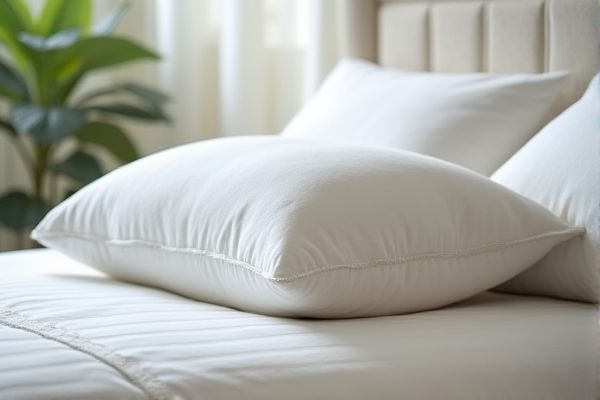
Hypoallergenic pillows are designed to resist allergens like dust mites, mold, and bacteria, making them ideal for sensitive skin or allergy sufferers, while memory foam pillows provide excellent support by contouring to your head and neck, promoting proper spinal alignment. Discover the key differences and benefits to find the perfect pillow that meets your sleep needs and preferences in the rest of the article.
Table of Comparison
| Feature | Hypoallergenic Pillow | Memory Foam Pillow |
|---|---|---|
| Material | Allergen-resistant synthetic fibers or natural materials | Viscoelastic polyurethane foam |
| Allergy Resistance | High - blocks dust mites, mold, and allergens | Moderate - resists dust mites but may retain some allergens |
| Support | Moderate support, varies by fill | Firm, molds to head and neck contours |
| Durability | Varies; synthetic fills last longer | High - typically lasts 2-3 years |
| Breathability | Usually good, depending on material | Lower breathability; may retain heat |
| Price Range | $20 - $80 | $30 - $150 |
| Ideal For | Allergy sufferers, sensitive skin | Neck pain relief, contour support seekers |
Understanding Hypoallergenic Pillows
Hypoallergenic pillows are designed to minimize the risk of allergic reactions by using materials resistant to common allergens like dust mites, mold, and pet dander, often incorporating synthetic fibers or specially treated natural fills. These pillows enhance sleep quality for allergy sufferers by maintaining a clean and breathable environment, thereby reducing symptoms such as sneezing, congestion, and skin irritation. Understanding their construction and benefits helps consumers make informed choices between hypoallergenic options and memory foam pillows, which primarily focus on support and pressure relief.
What is a Memory Foam Pillow?
A memory foam pillow is crafted from viscoelastic polyurethane foam that conforms to the shape of your head and neck, providing personalized support and pressure relief. Unlike hypoallergenic pillows, which are designed primarily to reduce allergens like dust mites and mold, memory foam pillows focus on enhancing comfort, spinal alignment, and durability. You enhance your sleep quality by choosing a memory foam pillow that adapts to your body's contours, offering both ergonomic support and long-lasting cushioning.
Key Differences: Hypoallergenic vs Memory Foam
Hypoallergenic pillows are designed to reduce allergens such as dust mites, mold, and pet dander, making them ideal for allergy sufferers, while memory foam pillows focus on providing superior support by contouring to the shape of Your head and neck. Memory foam pillow materials often retain heat and may emit an initial odor, whereas hypoallergenic pillows use breathable, hypoallergenic fabrics to enhance airflow and reduce irritation. Choosing between the two depends on whether You prioritize allergy protection or personalized ergonomic support.
Health Benefits of Hypoallergenic Pillows
Hypoallergenic pillows reduce exposure to allergens such as dust mites, mold, and pet dander, making them ideal for individuals with asthma or sensitive skin. They promote better respiratory health by minimizing allergic reactions and improving sleep quality through cleaner, allergen-free materials. Your overall well-being benefits from these pillows by reducing nighttime irritations and supporting a healthier sleep environment.
Comfort and Support: Memory Foam Pillows Explained
Memory foam pillows conform to the shape of your head and neck, providing personalized support that helps maintain proper spinal alignment and reduces pressure points. Their viscoelastic properties ensure consistent comfort by adapting to your body temperature and weight, making them ideal for people seeking tailored support and relief from neck pain. Hypoallergenic pillows may offer comfort by reducing allergens, but memory foam distinctly excels in delivering lasting support and comfort throughout the night.
Allergy Prevention: Which Pillow Wins?
Hypoallergenic pillows are specifically designed with materials that resist dust mites, mold, and bacteria, making them ideal for allergy prevention. Memory foam pillows, while providing excellent support and contouring to your head and neck, may retain heat and moisture, potentially fostering allergen buildup if not properly maintained. For optimal allergy prevention, your best choice is a hypoallergenic pillow that effectively minimizes exposure to common allergens.
Durability and Maintenance Comparison
Hypoallergenic pillows typically offer strong resistance to dust mites and allergens, making them easier to maintain with regular washing to preserve freshness and durability. Memory foam pillows provide excellent durability due to their dense structure but require special care, such as spot cleaning and airing, to prevent degradation and odor buildup. Choosing between the two depends on your maintenance preferences and how long you want your pillow to retain its supportive properties.
Temperature Regulation: Breathability Matters
Hypoallergenic pillows often use materials like cotton or wool that enhance breathability, promoting superior temperature regulation to prevent heat retention during sleep. Memory foam pillows tend to trap heat due to their dense structure, but newer variants incorporate cooling gel layers or open-cell foam technology to improve airflow and reduce warmth. Choosing between these pillows depends on individual sensitivity to allergens and preference for temperature control throughout the night.
Best Suitability for Different Sleepers
Hypoallergenic pillows are ideal for allergy sufferers and combine breathable materials that reduce dust mites and allergens, making them suitable for sensitive skin and those who require a clean sleep environment. Memory foam pillows provide excellent support and pressure relief by contouring to the head and neck, making them a perfect choice for side and back sleepers seeking spinal alignment and comfort. Side sleepers benefit from firmer memory foam for neck support, while stomach sleepers often prefer softer hypoallergenic pillows to avoid strain and maintain comfort.
Choosing the Right Pillow for Your Needs
Hypoallergenic pillows are ideal for individuals with allergies or sensitive skin as they resist dust mites, mold, and bacteria, providing a cleaner sleeping environment. Memory foam pillows offer superior support by contouring to the shape of your head and neck, promoting spinal alignment and reducing pressure points. Selecting the right pillow depends on personal comfort preferences, sleep position, and any specific health conditions such as allergies or neck pain.
 homyna.com
homyna.com